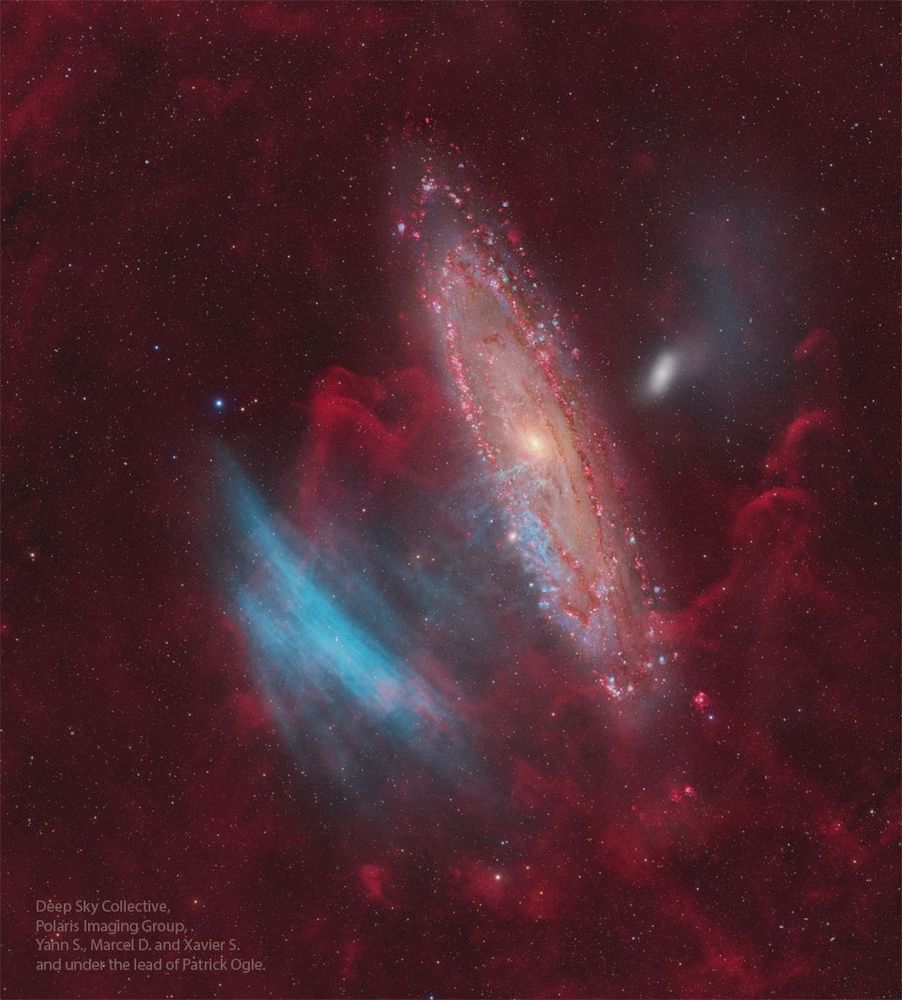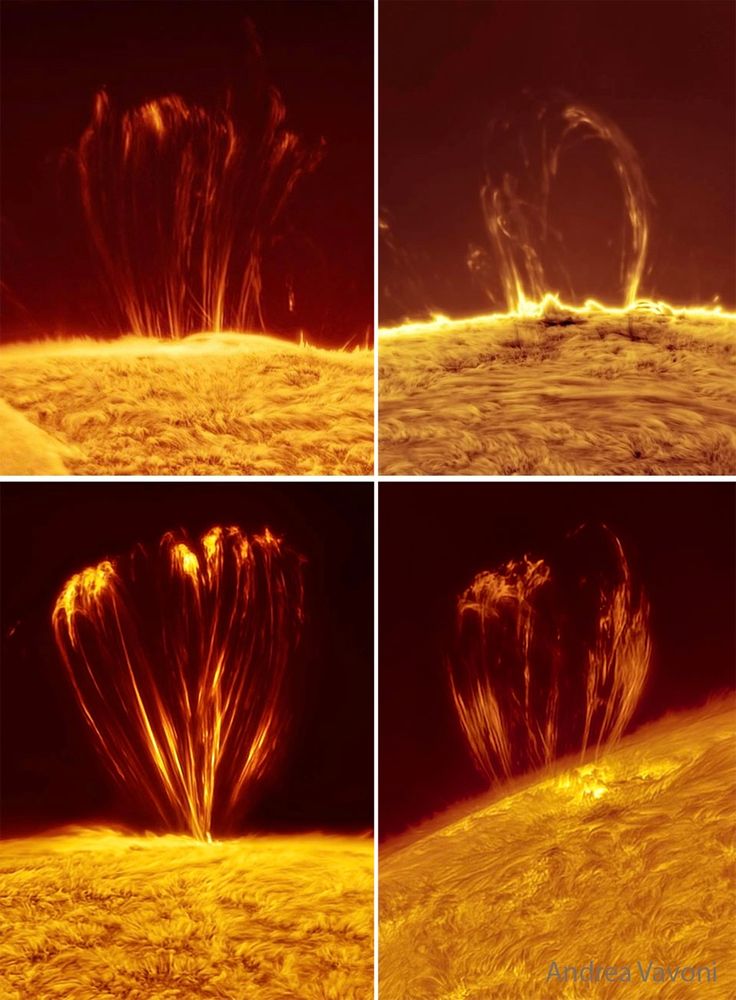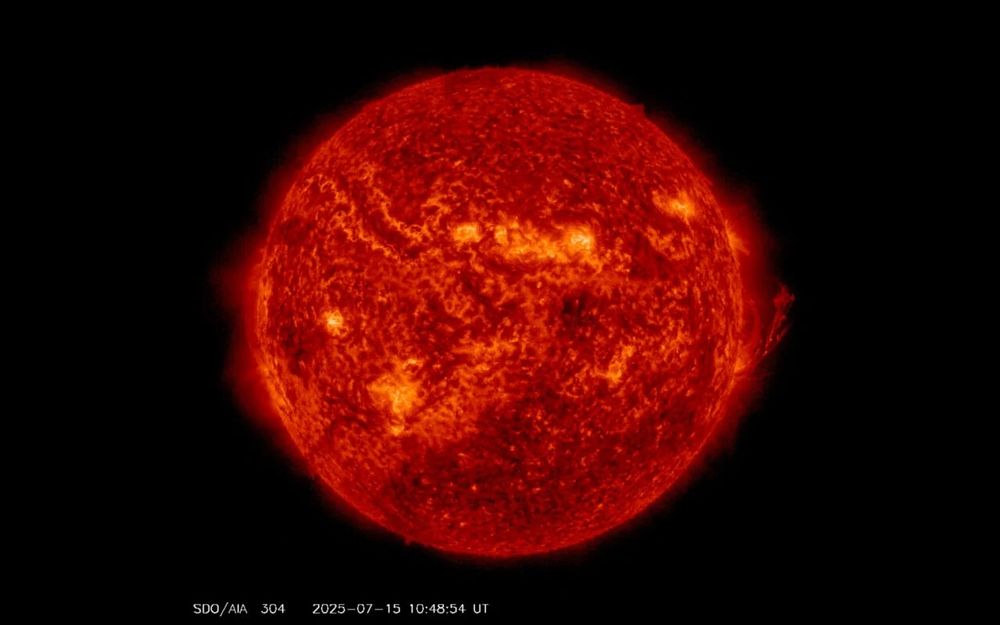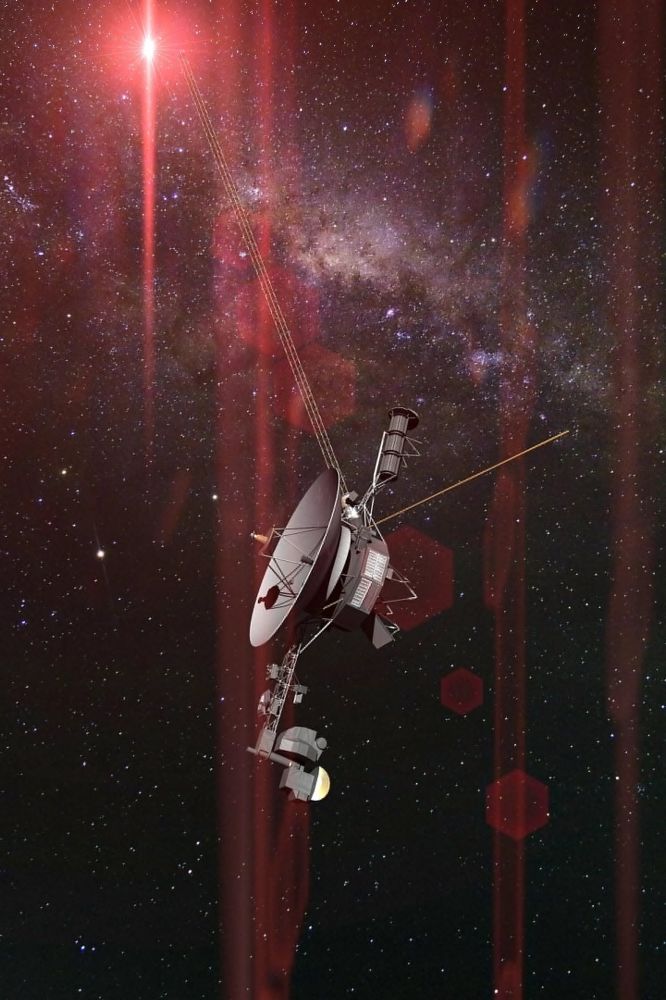
The James Webb Space Telescope spotted a gargantuan ravenous black hole in the ancient universe—nicknamed BiRD (Big Red Dot)—that existed just 4 billion years after the Big Bang.
Image credit: F. Loiacono, NASA, ESA, CSA
The James Webb Space Telescope spotted a gargantuan ravenous black hole in the ancient universe—nicknamed BiRD (Big Red Dot) that existed just 4 billion years after the Big Bang.
Image credit: F. Loiacono, NASA, ESA, CSA
05.11.2025 16:18 — 👍 190 🔁 29 💬 3 📌 3

An international team of scientists, including researchers at Penn State, dubbed the exoplanet, named GJ 251 c, a “super-Earth” as data suggest it has a rocky composition similar to Earth and is almost four times as massive. Credit: Illustration by University of California Irvine .
NEWS: Astronomers announce discovery of a "Super-Earth" in the habitable zone of a red dwarf star just 22 light years away
24.10.2025 15:01 — 👍 260 🔁 45 💬 24 📌 12

NGC 6357, dubbed the “Cathedral to Massive Stars,” dazzles in JWST’s view. Once thought a single 200-solar-mass star, Pismis 24-1 is actually three giants—each near 100 Suns! Newborn stars still emerge in this cosmic cathedral.
Credit: NASA/ESA/CSA/STScI, JWST
NGC 6357, dubbed the “Cathedral to Massive Stars,” dazzles in JWST’s view. Once thought a single 200-solar-mass star, Pismis 24-1 is actually three giants—each near 100 Suns! Newborn stars still emerge in this cosmic cathedral.
Credit: NASA/ESA/CSA/STScI, JWST
26.09.2025 16:51 — 👍 57 🔁 10 💬 1 📌 1
 06.09.2025 16:11 — 👍 9337 🔁 3136 💬 130 📌 101
06.09.2025 16:11 — 👍 9337 🔁 3136 💬 130 📌 101
Very beautiful.
05.08.2025 00:52 — 👍 0 🔁 0 💬 0 📌 0

Discovered in 2022, the massive blue arcs near the Andromeda Galaxy—SDSO 1 aren’t galactic neighbours, after all. They’re an entirely new class of faded planetary nebulae in our own Milky Way, dubbed Ghost Planetary Nebulae (GPN). A hauntingly beautiful find!
Credit: Ogle et al.
04.08.2025 17:07 — 👍 87 🔁 13 💬 3 📌 3

Majestic coronal loops dance above the Sun’s surface huge arcs of hot plasma shaped by magnetic fields. These stunning loops can last for days and are often found near sunspots. Some even unleash solar storms affecting Earth’s space weather!
Credit: Andrea Vanoni
Majestic coronal loops dance above the Sun’s surface huge arcs of hot plasma shaped by magnetic fields. These stunning loops can last for days and are often found near sunspots. Some even unleash solar storms affecting Earth’s space weather!
Credit: Andrea Vanoni
03.08.2025 17:35 — 👍 419 🔁 84 💬 6 📌 3

A colossal solar eruption just carved a blazing “canyon of fire” across the Sun's surface, stretching over 300,000 km! This dramatic event offers a stunning glimpse into our star’s explosive nature.
Credit: NASA/SDO
A colossal solar eruption just carved a blazing “canyon of fire” across the Sun's surface, stretching over 300,000 km! This dramatic event offers a stunning glimpse into our star’s explosive nature.
Credit: NASA/SDO
17.07.2025 17:34 — 👍 47 🔁 8 💬 1 📌 0

In the heart of M61 lies a spiralling mystery—its bright core contains a mini-spiral of gas feeding a supermassive black hole. Captured in stunning detail by Hubble and ground telescopes, M61 reveals cosmic beauty 55 million light-years away.
Credit: NASA, ESA, Hubble, ESO, R. Gendler
In the heart of M61 lies a spiralling mystery—its bright core contains a mini-spiral of gas feeding a supermassive black hole. Captured in stunning detail by Hubble and ground telescopes, M61 reveals cosmic beauty 55 million light-years away.
Credit: NASA, ESA, Hubble, ESO, R. Gendler
15.07.2025 16:52 — 👍 392 🔁 67 💬 6 📌 4

Image is edited on top of the image released by NASA/JPL Caltech
NASA saves Voyager 1 mission by successfully reviving frozen thrusters from almost 24 billion kilometers away
13.07.2025 01:58 — 👍 3993 🔁 629 💬 144 📌 64

A stunning mix of cosmic colors—M20, the Trifid Nebula, shows off red emission, blue reflection, and dark dust nebulae in one frame. Located 5,000 light-years away in Sagittarius, this stellar nursery spans 40 light-years across.
Image Credit : Alessandro Cipolat Bares
A stunning mix of cosmic colors—M20, the Trifid Nebula, shows off red emission, blue reflection, and dark dust nebulae in one frame. Located 5,000 light-years away in Sagittarius, this stellar nursery spans 40 light-years across.
Image Credit : Alessandro Cipolat Bares
10.07.2025 17:21 — 👍 57 🔁 9 💬 1 📌 0

A sky full of stories — or the eye of a dragon?
This surreal view over Askold Island, Russia, blends sunset, stars, clouds, and the Milky Way into a “Little Planet” projection of 38 stitched images. Look closer — a lone photographer stands within the dragon’s gaze.
Credit: Anton Komlev
A sky full of stories or the eye of a dragon?
This surreal view over Askold Island, Russia, blends sunset, stars, clouds, and the Milky Way into a “Little Planet” projection of 38 stitched images. Look closer a lone photographer stands within the dragon’s gaze.
Credit: Anton Komlev
01.07.2025 17:02 — 👍 39 🔁 5 💬 1 📌 0

The Sun unleashed a powerful X1.9-class solar flare on June 19 at 7:50 p.m. ET, captured in extreme ultraviolet by NASA’s Solar Dynamics Observatory. Such flares can disrupt power grids, radio, navigation, and pose risks to satellites and astronauts.
Image Credit: NASA/SDO
The Sun unleashed a powerful X1.9-class solar flare on June 19 at 7:50 p.m. ET, captured in extreme ultraviolet by NASA’s Solar Dynamics Observatory. Such flares can disrupt power grids, radio, navigation, and pose risks to satellites and astronauts.
Image Credit: NASA/SDO
23.06.2025 17:18 — 👍 101 🔁 28 💬 3 📌 0

Astronomers have finally found some of the universe’s long-missing ordinary matter a 23 million light-year filament of hot gas linking galaxy clusters in the Shapley Supercluster. At 10 million °C and 10× the Milky Way's mass, it supports our leading cosmic models.
Image: ESA/XMM-Newton, ISAS/JAXA
Astronomers have finally found some of the universe’s long-missing ordinary matter a 23 million light-year filament of hot gas linking galaxy clusters in the Shapley Supercluster. At 10 million °C and 10× the Milky Way's mass, it supports our leading cosmic models.
Image: ESA/XMM-Newton, ISAS/JAXA
21.06.2025 17:18 — 👍 80 🔁 8 💬 1 📌 1

NASA’s PUNCH mission has released its first wide-field images of powerful solar eruptions, called CMEs, travelling through space. Captured in unprecedented detail, these views will help scientists better understand space weather and protect satellites and astronauts.
Credit: NASA/SwRI
NASA’s PUNCH mission has released its first wide-field images of powerful solar eruptions, called CMEs, travelling through space. Captured in unprecedented detail, these views will help scientists better understand space weather and protect satellites and astronauts.
Credit: NASA/SwRI
12.06.2025 18:13 — 👍 58 🔁 10 💬 1 📌 1

Webb imaged two giant exoplanets orbiting young star YSES-1, 310 light-years away. One has a dusty disk, the other silicate clouds, revealing different stages of development. This rare discovery challenges current models of how planets form.
Image Credit: NASA, ESA, STScI, Nature, Reuters
Webb imaged two giant exoplanets orbiting young star YSES-1, 310 light-years away. One has a dusty disk, the other silicate clouds, revealing different stages of development. This rare discovery challenges current models of how planets form.
Image Credit: NASA, ESA, STScI, Nature, Reuters
13.06.2025 16:43 — 👍 77 🔁 14 💬 2 📌 1

Happy Pride Month! 🏳️🌈
01.06.2025 13:09 — 👍 21749 🔁 3486 💬 192 📌 125

A newborn star in the Orion B cloud unveils its power with twin cosmic jets, carving luminous paths through space. Captured by Hubble, Herbig-Haro 24 looks like a stellar lightsaber igniting a scene straight out of sci-fi.
Image Credit: NASA, ESA, Hubble Heritage, and collaborators
A newborn star in the Orion B cloud unveils its power with twin cosmic jets, carving luminous paths through space. Captured by Hubble, Herbig-Haro 24 looks like a stellar lightsaber igniting a scene straight out of sci-fi.
Image Credit: NASA, ESA, Hubble Heritage, and collaborators
28.05.2025 16:50 — 👍 351 🔁 66 💬 7 📌 2

The Tadpole Galaxy (UGC 10214) is a spiral galaxy with a 280,000-light-year tail, formed by a collision with a smaller galaxy. Blue star clusters in the tail may become dwarf galaxies.
Credit: NASA, ESA, H. Ford (JHU), G. Illingworth (UCSC/LO)
The Tadpole Galaxy (UGC 10214) is a spiral galaxy with a 280,000-light-year tail, formed by a collision with a smaller galaxy. Blue star clusters in the tail may become dwarf galaxies.
Credit: NASA, ESA, H. Ford (JHU), G. Illingworth (UCSC/LO)
08.05.2025 17:58 — 👍 280 🔁 33 💬 2 📌 7

Ways that we can fight this.
17.02.2025 05:21 — 👍 0 🔁 0 💬 0 📌 0
Democrats can't fire Elon Musk.
Republicans won't.
The only guy who can is Donald Trump and Elon Musk now has all of Trump's financial, business, and personal information. Everything the IRS, FBI, CIA, et al, knows about him. Musk has it all.
06.02.2025 20:50 — 👍 1081 🔁 239 💬 62 📌 31
Musk posted on X today, stating, “Medicare is where the big money fraud is happening.” The Department of Health and Human Services spends nearly $2 trillion annually, mostly on health insurance programs like Medicare and Medicaid, making it a prime target.
06.02.2025 05:42 — 👍 1666 🔁 350 💬 98 📌 50
They have also sought access to payment and contracting systems across HHS, which manage hundreds of billions of dollars in annual payments to health care providers. Musk’s staff has already gained access to these systems, including CMS’s grant-management system.
06.02.2025 05:42 — 👍 1466 🔁 226 💬 16 📌 3
These moves came after Musk’s team gained access to sensitive health payment systems within the Department of Health and Human Services (HHS), the CDC, and the Centers for Medicare and Medicaid Services (CMS).
06.02.2025 05:42 — 👍 653 🔁 115 💬 7 📌 0
Musk’s staffers fanned out across several agencies today, sending representatives to the Atlanta headquarters of the Centers for Disease Control and Prevention (CDC) and meeting with the Labor Department to seek access to sensitive data.
06.02.2025 05:42 — 👍 5078 🔁 1225 💬 204 📌 96
We're in the midst of a constitutional crisis.
The world's richest man is effectively orchestrating a coup.
At the very least, Senate Dems should not be confirming any of Trump’s nominees for any agency while this power grab continues.
Nothing should be "business as usual."
05.02.2025 17:31 — 👍 8194 🔁 1925 💬 289 📌 99
This. Make it hard for the Republicans to destroy the country.
05.02.2025 22:04 — 👍 5967 🔁 1051 💬 147 📌 51

It’s a very common question these days in light of all these attacks upon our Republic: Is somebody doing something?! The good news is, they are. I break it down and discuss the four kinds of responses that are happening today. Link in the replies.
03.02.2025 18:50 — 👍 1185 🔁 250 💬 41 📌 22
Attn: Treasury Secretary Scott Bessent granted representatives of the so-called Department of Government Efficiency full access to the federal payment system!
01.02.2025 20:56 — 👍 4711 🔁 1334 💬 327 📌 176



 06.09.2025 16:11 — 👍 9337 🔁 3136 💬 130 📌 101
06.09.2025 16:11 — 👍 9337 🔁 3136 💬 130 📌 101
















